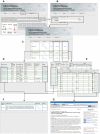hERGAPDbase: a database documenting hERG channel inhibitory potentials and APD-prolongation activities of chemical compounds
- PMID: 21586548
- PMCID: PMC3096323
- DOI: 10.1093/database/bar017
hERGAPDbase: a database documenting hERG channel inhibitory potentials and APD-prolongation activities of chemical compounds
Abstract
Drug-induced QT interval prolongation is one of the most common reasons for the withdrawal of drugs from the market. In the past decade, at least nine drugs, i.e. terfenadine, astemizole, grepafloxacin, terodiline, droperidol, lidoflazine, sertindole, levomethadyl and cisapride, have been removed from the market or their use has been severely restricted because of drug-induced QT interval prolongation. Therefore, this irregularity is a major safety concern in the case of drugs submitted for regulatory approval. The most common mechanism of drug-induced QT interval prolongation may be drug-related inhibition of the human ether-á-go-go-related gene (hERG) channel, which subsequently results in prolongation of the cardiac action potential duration (APD). hERGAPDbase is a database of electrophysiological experimental data documenting potential hERG channel inhibitory actions and the APD-prolongation activities of chemical compounds. All data entries are manually collected from scientific papers and curated by a person. With hERGAPDbase, we aim to provide useful information for chemical and pharmacological scientists and enable easy access to electrophysiological experimental data on chemical compounds. Database URL: http://www.grt.kyushu-u.ac.jp/hergapdbase/.
Figures






Similar articles
-
Comparative pharmacology of guinea pig cardiac myocyte and cloned hERG (I(Kr)) channel.J Cardiovasc Electrophysiol. 2004 Nov;15(11):1302-9. doi: 10.1046/j.1540-8167.2004.04099.x. J Cardiovasc Electrophysiol. 2004. PMID: 15574182
-
Relationships between preclinical cardiac electrophysiology, clinical QT interval prolongation and torsade de pointes for a broad range of drugs: evidence for a provisional safety margin in drug development.Cardiovasc Res. 2003 Apr 1;58(1):32-45. doi: 10.1016/s0008-6363(02)00846-5. Cardiovasc Res. 2003. PMID: 12667944 Review.
-
Predicting QT prolongation in humans during early drug development using hERG inhibition and an anaesthetized guinea-pig model.Br J Pharmacol. 2008 Aug;154(7):1446-56. doi: 10.1038/bjp.2008.267. Epub 2008 Jun 30. Br J Pharmacol. 2008. PMID: 18587422 Free PMC article.
-
Acute effects of oestrogen on the guinea pig and human IKr channels and drug-induced prolongation of cardiac repolarization.J Physiol. 2008 Jun 15;586(12):2961-73. doi: 10.1113/jphysiol.2007.150367. Epub 2008 Apr 25. J Physiol. 2008. PMID: 18440994 Free PMC article.
-
The pre-clinical assessment of QT interval prolongation: a comparison of in vitro and in vivo methods.Hum Exp Toxicol. 1998 Dec;17(12):677-80. doi: 10.1177/096032719801701205. Hum Exp Toxicol. 1998. PMID: 9988372 Review.
Cited by
-
Dealing with the Data Deluge: Handling the Multitude Of Chemical Biology Data Sources.Curr Protoc Chem Biol. 2012 Sep;4:193-209. doi: 10.1002/9780470559277.ch110262. Epub 2012 Sep 1. Curr Protoc Chem Biol. 2012. PMID: 26609498 Free PMC article.
-
Cisapride induced hypoglycemia via the KCNH6 potassium channel.Front Endocrinol (Lausanne). 2022 Oct 17;13:1011238. doi: 10.3389/fendo.2022.1011238. eCollection 2022. Front Endocrinol (Lausanne). 2022. PMID: 36325440 Free PMC article.
-
The state of the art in secondary pharmacology and its impact on the safety of new medicines.Nat Rev Drug Discov. 2024 Jul;23(7):525-545. doi: 10.1038/s41573-024-00942-3. Epub 2024 May 21. Nat Rev Drug Discov. 2024. PMID: 38773351 Review.
-
LncRNA MALAT1/Calpain-1 Axis in ATO Induced hERG Channel Deficiency.Drug Des Devel Ther. 2025 Feb 28;19:1475-1487. doi: 10.2147/DDDT.S502776. eCollection 2025. Drug Des Devel Ther. 2025. PMID: 40041754 Free PMC article.
-
A structure-based computational workflow to predict liability and binding modes of small molecules to hERG.Sci Rep. 2020 Oct 1;10(1):16262. doi: 10.1038/s41598-020-72889-5. Sci Rep. 2020. PMID: 33004839 Free PMC article.
References
-
- Friedrichs GS, Patmore L, Bass A. Non-clinical evaluation of ventricular repolarization (ICH S7B): results of an interim survey of international pharmaceutical companies. J. Pharmacol. Toxicol. Methods. 2005;52:6–11. - PubMed
-
- Kang J, Wang L, Chen XL, et al. Interactions of a series of fluoroquinolone antibacterial drugs with the human cardiac K+ channel HERG. Mol. Pharmacol. 2001;59:122–126. - PubMed
-
- Bowlby MR, Peri R, Zhang H, et al. hERG (KCNH2 or Kv11.1) K+ channels: Screening for cardiac arrhythmia risk. Curr. Drug Metab. 2008;9:965–970. - PubMed
-
- Ando K. Drug-induced QT prolongation: individual susceptibility and regulatory issues related to safety pharmacology 2. Evaluation of QT interval prolongation in non-clinical studies according to ICH S7A and S7B and its questions at issue. Jpn. J. Clin. Pharmacol. Ther. 2006;37:201–206.
Publication types
MeSH terms
Substances
LinkOut - more resources
Full Text Sources
Miscellaneous

